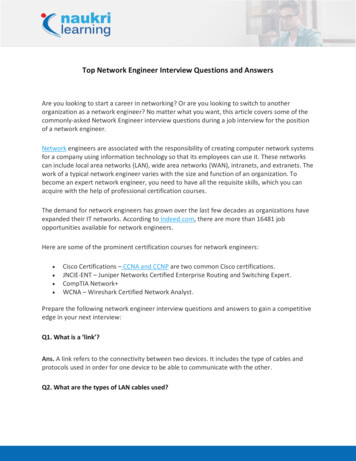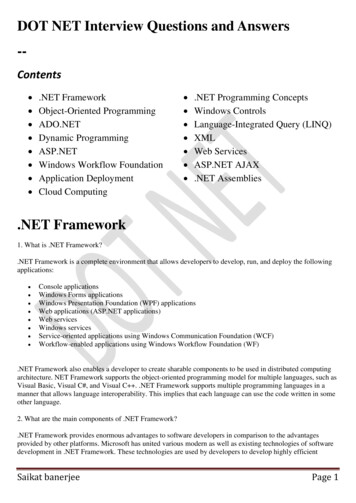
Transcription
DOT NET Interview Questions and Answers-Contents .NET FrameworkObject-Oriented ProgrammingADO.NETDynamic ProgrammingASP.NETWindows Workflow FoundationApplication DeploymentCloud Computing .NET Programming ConceptsWindows ControlsLanguage-Integrated Query (LINQ)XMLWeb ServicesASP.NET AJAX.NET Assemblies.NET Framework1. What is .NET Framework?.NET Framework is a complete environment that allows developers to develop, run, and deploy the followingapplications: Console applicationsWindows Forms applicationsWindows Presentation Foundation (WPF) applicationsWeb applications (ASP.NET applications)Web servicesWindows servicesService-oriented applications using Windows Communication Foundation (WCF)Workflow-enabled applications using Windows Workflow Foundation (WF).NET Framework also enables a developer to create sharable components to be used in distributed computingarchitecture. NET Framework supports the object-oriented programming model for multiple languages, such asVisual Basic, Visual C#, and Visual C . .NET Framework supports multiple programming languages in amanner that allows language interoperability. This implies that each language can use the code written in someother language.2. What are the main components of .NET Framework?.NET Framework provides enormous advantages to software developers in comparison to the advantagesprovided by other platforms. Microsoft has united various modern as well as existing technologies of softwaredevelopment in .NET Framework. These technologies are used by developers to develop highly efficientSaikat banerjeePage 1
applications for modern as well as future business needs. The following are the key components of .NETFramework: .NET Framework Class LibraryCommon Language RuntimeDynamic Language Runtimes (DLR)Application DomainsRuntime HostCommon Type SystemMetadata and Self-Describing ComponentsCross-Language Interoperability.NET Framework SecurityProfilingSide-by-Side Execution3. List the new features added in .NET Framework 4.0.The following are the new features of .NET Framework 4.0: Improved Application Compatibility and Deployment SupportDynamic Language RuntimeManaged Extensibility FrameworkParallel Programming frameworkImproved Security ModelNetworking ImprovementsImproved Core ASP.NET ServicesImprovements in WPF 4Improved Entity Framework (EF)Integration between WCF and WF4. What is an IL?Intermediate Language is also known as MSIL (Microsoft Intermediate Language) or CIL (CommonIntermediate Language). All .NET source code is compiled to IL. IL is then converted to machine code at thepoint where the software is installed, or at run-time by a Just-In-Time (JIT) compiler.5. What is Manifest?Assembly metadata is stored in Manifest. Manifest contains all the metadata needed to do the following things Version of assembly.Security identity.Scope of the assembly.Resolve references to resources and classes.The assembly manifest can be stored in a PE file either (an .exe or) .dll with Microsoftintermediate language (MSIL code with Microsoft intermediate language (MSIL) code or in astand-alone PE file, that contains only assembly manifest information.6. What are code contracts?Code contracts help you to express the code assumptions and statements stating the behavior of your code in alanguage-neutral way. The contracts are included in the form of pre-conditions, post-conditions and object-Saikat banerjeePage 2
invariants. The contracts help you to improve-testing by enabling run-time checking, static contractverification, and documentation generation.The System.Diagnostics.Contracts namespace contains static classes that are used to express contracts in yourcode.7. Name the classes that are introduced in the System.Numerics namespace.The following two new classes are introduced in the System.Numerics namespace: BigInteger - Refers to a non-primitive integral type, which is used to hold a value of any size. It has nolower and upper limit, making it possible for you to perform arithmetic calculations with very largenumbers, even with the numbers which cannot hold by double or long.Complex - Represents complex numbers and enables different arithmetic operations with complexnumbers. A number represented in the form a bi, where a is the real part, and b is the imaginary part,is a complex number.8. What is managed extensibility framework?Managed extensibility framework (MEF) is a new library that is introduced as a part of .NET 4.0 andSilverlight 4. It helps in extending your application by providing greater reuse of applications and components.MEF provides a way for host application to consume external extensions without any configurationrequirement.9. Explain memory-mapped files.Memory-mapped files (MMFs) allow you map the content of a file to the logical address of an application.These files enable the multiple processes running on the same machine to share data with each Other. TheMemoryMappedFile.CreateFromFile() method is used to obtain a MemoryMappedFile object that represents apersisted memory-mapped file from a file on disk.These files are included in the System.IO.MemoryMappedFiles namespace. This namespace contains fourclasses and three enumerations to help you access and secure your file mappings.10. What is Common Type System (CTS)?CTS is the component of CLR through which .NET Framework provides support for multiple languagesbecause it contains a type system that is common across all the languages. Two CTS-compliant languages donot require type conversion when calling the code written in one language from within the code written inanother language. CTS provide a base set of data types for all the languages supported by.NET Framework.This means that the size of integer and long variables is same across all .NET-compliant programminglanguages. However, each language uses aliases for the base data types provided by CTS. For example, CTSuses the data type system. int32 to represent a 4 byte integer value; however, Visual Basic uses the alias integerfor the same; whereas, C# uses the alias int. This is done for the sake of clarity and simplicity.11. Give a brief introduction on side-by-side execution. Can two applications, one using private assembly andthe other using the shared assembly be stated as side-by-side executables?Side-by-side execution enables you to run multiple versions of an application or component and CLR on thesame computer at the same time. As versioning is applicable only to shared assemblies and not to privateassemblies, two applications, one using a private assembly and other using a shared assembly, cannot be statedas side-by-side executables.12. Which method do you use to enforce garbage collection in .NET?Saikat banerjeePage 3
The System.GC.Collect() method.13. State the differences between the Dispose() and Finalize().CLR uses the Dispose and Finalize methods to perform garbage collection of run-time objects of .NETapplications.The Finalize method is called automatically by the runtime. CLR has a garbage collector (GC), whichperiodically checks for objects in heap that are no longer referenced by any object or program. It calls theFinalize method to free the memory used by such objects. The Dispose method is called by the programmer.Dispose is another method to release the memory used by an object. The Dispose method needs to be explicitlycalled in code to dereference an object from the heap. The Dispose method can be invoked only by the classesthat implement the IDisposable interface.14. What is code access security (CAS)?Code access security (CAS) is part of the .NET security model that prevents unauthorized access of resourcesand operations, and restricts the code to perform particular tasks.15. Differentiate between managed and unmanaged code?Managed code is the code that is executed directly by the CLR instead of the operating system. The codecompiler first compiles the managed code to intermediate language (IL) code, also called as MSIL code. Thiscode doesn't depend on machine configurations and can be executed on different machines.Unmanaged code is the code that is executed directly by the operating system outside the CLR environment. Itis directly compiled to native machine code which depends on the machine configuration.In the managed code, since the execution of the code is governed by CLR, the runtime provides differentservices, such as garbage collection, type checking, exception handling, and security support. These serviceshelp provide uniformity in platform and language-independent behavior of managed code applications. In theunmanaged code, the allocation of memory, type safety, and security is required to be taken care of by thedeveloper. If the unmanaged code is not properly handled, it may result in memory leak. Examples ofunmanaged code are ActiveX components and Win32 APIs that execute beyond the scope of native CLR.16. What are tuples?Tuple is a fixed-size collection that can have elements of either same or different data types. Similar to arrays, auser must have to specify the size of a tuple at the time of declaration. Tuples are allowed to hold up from 1 to8 elements and if there are more than 8 elements, then the 8th element can be defined as another tuple. Tuplescan be specified as parameter or return type of a method.17. How can you turn-on and turn-off CAS?YOU can use the Code Access Security Tool (Caspol.exe) to turn security on and off.To turn off security, type the following command at the command prompt:caspol -security offTo turn on security, type the following command at the command prompt:caspol -security onIn the .NET Framework 4.0, for using Caspol.exe, you first need to set the LegacyCasPolicy element totrue.Saikat banerjeePage 4
18. What is garbage collection? Explain the difference between garbage collections in .NET 4.0 and earlierversions.Garbage collection prevents memory leaks during execution of programs. Garbage collector is a low-priorityprocess that manages the allocation and deallocation of memory for your application. It checks for theunreferenced variables and objects. If GC finds any object that is no longer used by the application, it frees upthe memory from that object.GC has changed a bit with the introduction of .NET 4.0. In .NET 4.0, the GC.Collect() method contains thefollowing overloaded methods:GC.Collect(int)GC.Collect(int, GCCollectionMode)Another new feature introduced in .NET is to notify you when the GC.Collect() method is invoked andcompleted successfully by using different methods. The .NET 4.0 supports a new background garbagecollection that replaces the concurrent garbage collection used in earlier versions. This concurrent GC allocatesmemory while running and uses current segment (which is 16 MB on a workstation) for that. After that, allthreads are suspended. In case of background GC, a separate ephemeral GC - gen0 and gen1 can be started,while the full GC - gen0, 1, and 2 - is already running.19. How does CAS works?There are two key concepts of CAS security policy- code groups and permissions. A code group containsassemblies in it in a manner that each .NET assembly is related to a particular code group and somepermissions are granted to each code group. For example, using the default security policy, a controldownloaded from a Web site belongs to the Zone, Internet code group, which adheres to the permissionsdefined by the named permission set. (Normally, the named permission set represents a very restrictive range ofpermissions.)Assembly execution involves the following steps:1.2.3.4.Evidences are gathered about assembly.Depending on the gathered evidences, the assembly is assigned to a code group.Security rights are allocated to the assembly, depending on the code group.Assembly runs as per the rights assigned to it.20. What is Difference between NameSpace and Assembly?Following are the differences between namespace and assembly: Assembly is physical grouping of logical units, Namespace, logically groups classes.Namespace can span multiple assembly.21. Mention the execution process for managed code.A piece of managed code is executed as follows: Choosing a language compilerCompiling the code to MSILCompiling MSIL to native codeExecuting the code.22. Is there a way to suppress the finalize process inside the garbage collector forcibly in .NET?Saikat banerjeePage 5
Use the GC.SuppressFinalize() method to suppress the finalize process inside the garbage collector forcibly in.NET.23. How can you instantiate a tuple?The following are two ways to instantiate a tuple: Using the new operator. For example,Tuple String, int t new Tuple String, int ("Hellow", 2); Using the Create factory method available in the Tuple class. For example,Tuple int, int, int t Tuple.Create int, int, int (2, 4, 5);24. Which is the root namespace for fundamental types in .NET Framework?System.Object is the root namespace for fundamental types in .NET Framework.25. What are the improvements made in CAS in .NET 4.0?The CAS mechanism in .NET is used to control and configure the ability of managed code. Earlier, as thispolicy was applicable for only native applications, the security guarantee was limited. Therefore, developersused to look for alternating solutions, such as operating system-level solutions. This problem was solved in.NET Framework 4 by turning off the machine-wide security. The shared and hosted Web applications can nowrun more securely. The security policy in .NET Framework 4 has been simplified using the transparency model.This model allows you to run the Web applications without concerning about the CAS policies.As a result of security policy changes in .NET Framework 4.0, you may encounter compilation warnings andruntime exceptions, if your try to use the obsolete CAS policy types and members either implicitly or explicitly.However, you can avoid the warnings and errors by using the NetFx40 LegacySecurityPolicy configurati
DOT NET Interview Questions and Answers -- Contents .NET Framework .NET Programming Concepts Object-Oriented Programming Windows Controls ADO.NET Language-Integrated Query (LINQ) Dynamic Programming XML ASP.NET Web Services Windows Workflow Foundation ASP.NET AJAX Application Deployment .NET Assemblies Cloud Computing .NET Framework 1. What is .NET
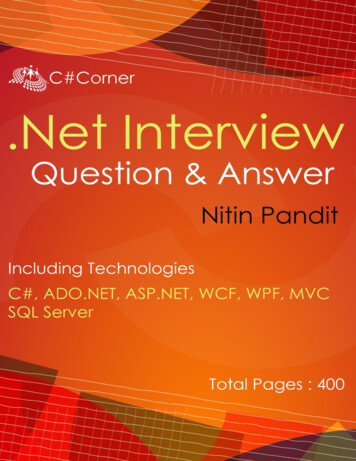
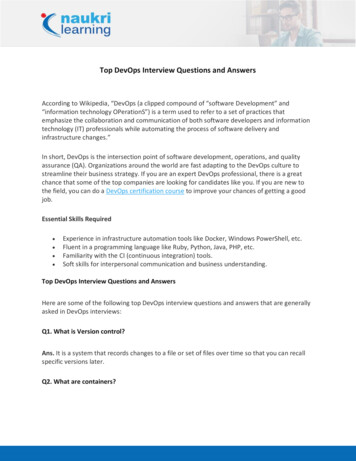
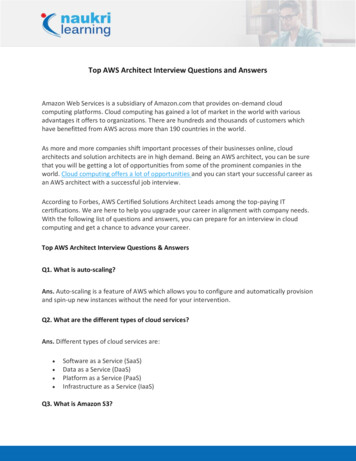
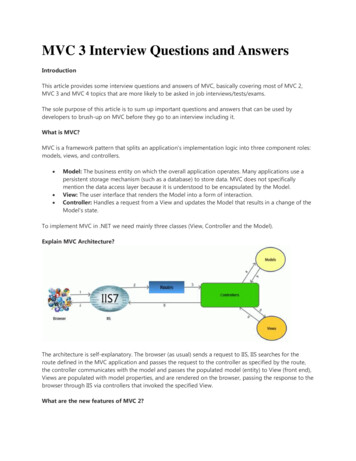
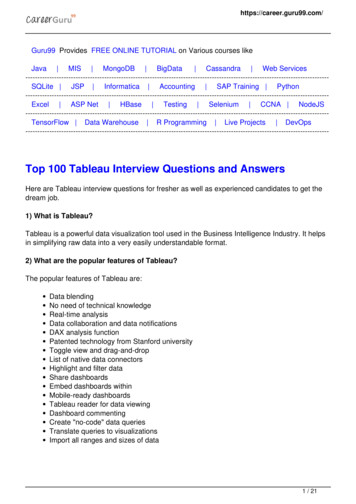

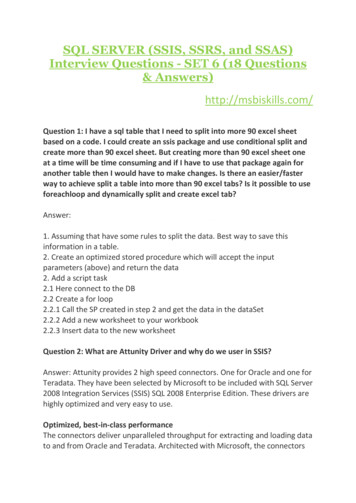
![Informatica Interview Questions and Answers [Scenario-Based]](/img/2/informatica-interview-questions-and-answers-scenario-based-1.jpg)

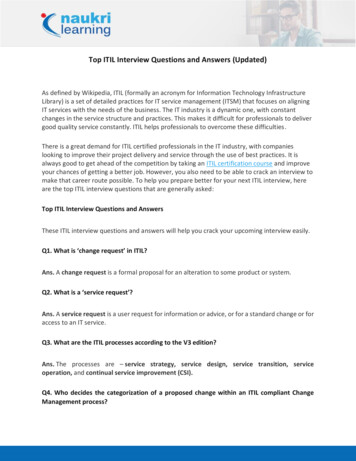
![Top Networking Interview Questions and Answers [Updated]](/img/3/top-networking-interview-questions-and-answers-updated.jpg)
